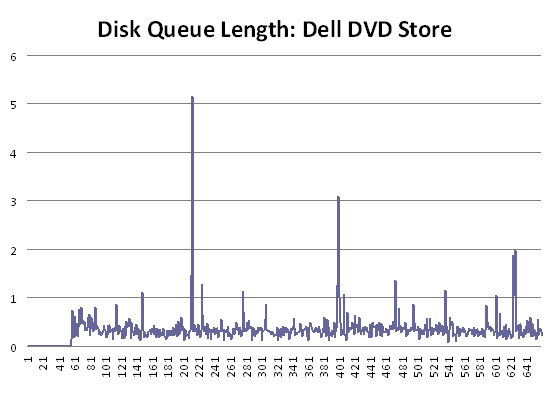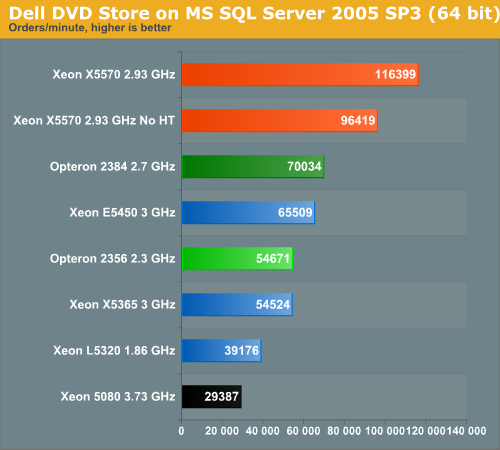The Best Server CPUs part 2: the Intel "Nehalem" Xeon X5570
by Johan De Gelas on March 30, 2009 3:00 PM EST- Posted in
- IT Computing
| OLTP: Dell DVD Store on MS SQL Server 2005 | |
| Operating System | Windows 2008 Enterprise RTM (64-bit) |
| Software | SQL Server 2005 Enterprise x64 SP3 (64-bit) |
| Benchmark software | Dell DVDStore 2 |
| Database Size | 3.5 GB |
| Typical error margin | 2-4% |
DVD Store is a project that the Linux department of Dell developed in 2005 as a test for its internal server laboratory. The DVD Store database schema consists of only eight tables, but it does include stored procedures and transactions. The beauty is that it is available as open source software. This allowed us to turn this into a custom benchmark. With the default settings, the database can only be three sizes: 10MB, 1GB, or 100GB. A 10MB database size is simply too small. A 1GB size does not allow us to scale well, as too much locking contention happens. Those two options are out, but to run DVD Store with a 100GB database as a CPU benchmark, we need to take out a second mortgage on all the houses of our team to pay for the necessary storage racks.
We decided to recompile the test, allowing us to use a 3.5GB database. A 3.5GB database proved to be a good compromise between not needing too much storage speed and making the database scale well to eight cores and beyond. As you can read on our benchmark configuration page, we used a RAID 0 set of six SSDs for the data, and four 15000RPM SAS disks for the logs. We monitored the DQL (Disk Queue Length) to ensure our test was not bottlenecked by the storage subsystem.

Most of the time, our storage subsystem copes well with the transactions (DQL <1), but there are a few brief spikes where the disks are limiting throughput. This means that our fastest CPUs are running at a slightly lower CPU load (Xeon X5570 is at slightly less than 80%) than the slowest CPU (85%). Giving our fastest CPUs an even faster storage system hardly improved performance despite somewhat higher CPU load levels. In reality, it is very unlikely that you will add a few drives because you wish to run your CPU at an 82% instead of 78% CPU load, so we feel this small variation in CPU load is acceptable. This is especially true as the resulting variation in performance is much smaller: we are talking about 2-3% performance variations, well within the error margin of our test.
You can test this OLTP database via a very thin web tier or directly. As the web tier only added noise (it uses the slow ODBC driver!) to our results, we tested directly. All servers were tested in a dual CPU configuration.

The AMD Shanghai has no trouble leaving the older Xeons behind, even at a lower clock speed. The Xeon 5570 does not play in the same class. Thanks to SMT, it is capable of outperforming its older brother by 78% and the competition by 66%. Hyper-Threading gives the Xeon 5570 a 21% performance boost.
One Xeon 5570 server is capable of replacing 3 to 4 older server systems based on the Xeon 50xx series.










44 Comments
View All Comments
Veteran - Wednesday, April 1, 2009 - link
I didn't mean to offend you, because i can imagine how much time it takes to test hardware properly. And i personally think that OLTP/OLAP testing is very innovative and needed. Because otherwise people would have no idea what to buy for servers. You cannot let you server purchase be influenced with meaningless (for servers) simple benchmarks like 3D 2006/Vantage/FPS test etc.You guys always are doing a great a job at testing any piece of hardware, but it is just feeling to much biased towards Intel. For example, at the last page of this review you get a link to Intel resource Center (in the same place as the next button). If you have things like that, you are not (trying to be) objective IMO.
JohanAnandtech - Wednesday, April 1, 2009 - link
Thank you for clarifying in a very constructive way."the last page of this review you get a link to Intel resource Center"
I can't say I am happy with that link as it creates the wrong impression. But the deal is: editors don't involve in ad management, ad sales people don't get involved when it comes to content.
So all I can say is to judge our content, not our ads. And like I said, it didn't stop us from claiming that Shanghai was by far the best server CPU a few months ago. And that conclusion was not on many sites.
Veteran - Wednesday, April 1, 2009 - link
Thanks for clarrifying this matter.But ad sales people should know this creates the wrong impression. A review site (for me at least) is all about objectivity and credibility. When you place a link to Intel's Resource Center at the end of every review, it feels weird. People on forums already call Anandtech, Inteltech. And i don't think this is what you guys want.
I always liked Anandtech since when I was a kid, and I still do. You guys always have one of the most in-depth reviews (especially on the very technical side) and I like that. But you guys are gaining some very negative publicity on the net.
BaronMatrix - Tuesday, March 31, 2009 - link
Unfortunately, I don't buy from or recommend criminals.carniver - Wednesday, April 1, 2009 - link
AMDZone is the biggest joke on the internet. I just went there to see how the zealots like abinstein are still doing their damage control; just like before he went on rambling how the Penryn is still weak against Shanghai, and the old and tired excuses like how if people all bought AMD they can drop in upgrades etc etc. ZootyGray...he's the biggest joke on AMDZone. None of them had the mental capacity to accept AMD has been DEFEATED, which is disappointing but funny to say the leastduploxxx - Wednesday, April 1, 2009 - link
It's not just AMDZone, you are just the opposite. Its like in Woodcrest and conroe times, it's not because the high-end cpu is the best of all that the rest of the available cpu's in the line is by default better. It's all about price performance ratio. Like many who were buying the low-end and think they had bought the better system, well wrong bet.As mentioned before, why not test the mid range that is where the sales will be. Time to test 5520-5530 against 2380-82 after all those have the same price.
carniver - Wednesday, April 1, 2009 - link
Your argument is valid, however, it just so happens that for low end 1S systems the Penryns are doing just fine against the Shanghais, for higher end 2S systems they used to be limited by memory bandwidth and AMD pulls ahead. No more is this the case, Intel now beats AMD in their own territory.CHADBOGA - Tuesday, March 31, 2009 - link
You probably also can't afford to buy a computer, so I doubt that Intel will be too concerned with your AMDZone insanity. LOL!!!!smilingcrow - Tuesday, March 31, 2009 - link
Those grapes you are chewing on sure sound sour to me. Try listening to a few tracks by The Fun Loving Criminals to help take away the bad taste.cjcoats - Tuesday, March 31, 2009 - link
There's more to HPC applications than you indicate: environmental modeling apps, particularly, tend to be dominated by memory access patterns rather than by I/O or pure computation. Give me a ring if you'd like some help with that -- I'm local for you, in fact...